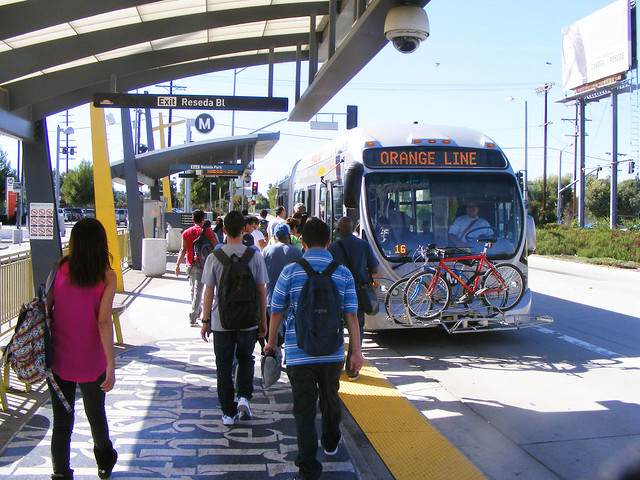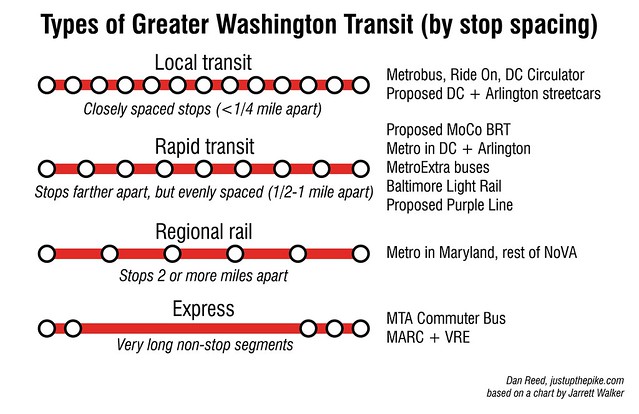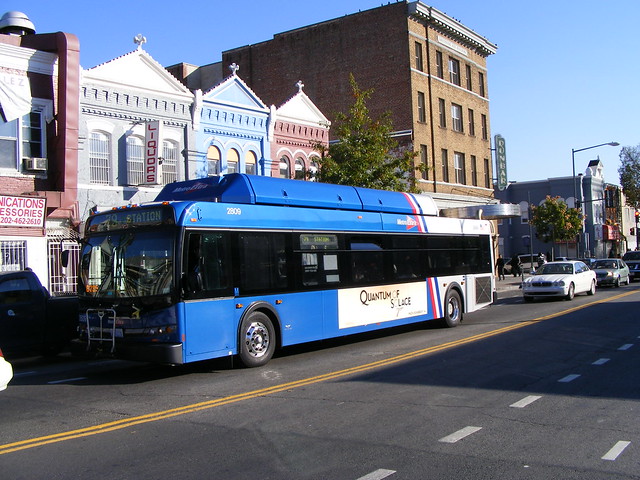 |
| Montgomery County wants BRT like Los Angeles, but what will it take to get there? |
Supporters of Montgomery County's proposed Bus Rapid Transit network like to highlight its vast network of routes, compelling new technology and potential to spur economic development. However, it's important not to forget to focus on the fundamental goal: getting people where they want to go in a faster or more convenient fashion.
A countywide BRT system was first proposed 4 years ago. Since then, it's been studied by transportation consultants, a task force of county residents, and most recently county planners. Yet judging from open houses held during the fall, the general public appears to be either unconvinced of BRT's merits or hostile to it.
Why is that? For all of the discussion that's been had over BRT, we haven't spent enough time talking about it as a tool for moving people and for filling gaps in our transportation network. It's not enough to say why BRT is great, but rather why it's great for our specific problems in Montgomery County. That's the only way taxpayers can justify spending $1.8 billion to build and millions more to operate a new transit system.
There are two points that I feel could point the conversation over BRT in the right direction:
1) Bus Rapid Transit compliments rather than competes with existing service.
Both online and off, I've heard from residents who argue that BRT will compete with Metro or that it's only for long-distance commuters coming from Frederick or Howard counties.
These claims ignore the distinctions between different kinds of transit. Transit planner and blogger Jarrett Walker uses three categories to describe different services based on their stop spacing: local transit that makes lots of stops close together, rapid transit that makes stops that are about 1/2-mile to a mile apart but still evenly spaced, and express transit that makes very few stops, very far apart. For the DC area, I'd add a fourth category for the Metro, which has evenly-spaced stops like a "rapid" service, but they can be over 2 miles apart in Montgomery County and much of the region. Here are those four categories in a handy chart:
 |
| The difference between "local," "rapid" and "express" transit. |
Each service does different things for different people, and in a larger system they can complement each other. For instance, today the Route 29 corridor between Silver Spring and Burtonsville is served by local buses like the Metrobus Z6, which makes lots of stops along a windy, circuitous route, and express buses like the MTA 929 commuter bus, which makes just 3 stops before heading north to Howard County.
BRT would be the middle ground: it would be faster than local buses, but serve more neighborhoods and destinations than the express bus. Commuters going from Columbia to Silver Spring might find it too slow, but for folks coming from White Oak, which the 929 passes over, it would be a welcome alternative to the Z6.
2) BRT isn't a fixed menu, but a buffet.
Many transit services come as a complete package, like a prix fixe menu at a restaurant. For instance, a heavy rail system like the Metro has to have rails and has to be separated from cars and people. You can't have one without the other.
BRT, meanwhile, is comprised of many different features that can be used independently of one another. You can give buses priority at stoplights without having dedicated lanes, or you can have off-board fare collection without having special buses.
 |
| MetroExtra, shown here in the District, can get us to BRT sooner rather than later. |
Of course, you can get a faster, more efficient service if you include all of those things, and that's why the county's proposed BRT network would do just that. I've written before that BRT simply won't be successful without dedicated lanes in the county's most congested areas.
Nonetheless, transit ridership is higher in some parts of the county than others simply because of how they're laid out, and there are areas where doing everything on the "BRT menu" won't be effective. Given, this could lead to what Dan Malouff calls "BRT creep," when a service is slowly stripped down until it's just a regular bus. That's bad for commuters, but it's also bad for taxpayers who were sold a high-end service only to find out that we just painted the buses a different color.
However, it may still make sense to take a measured approach, and start experimenting with some aspects of BRT now rather than rushing to build out an entire system. The Action Committee for Transit, where I serve as Land Use Chair, has recommended rolling out Metro's Priority Corridor Initiative, which focuses on small fixes to speed up existing bus routes. The "rapid" MetroExtra bus routes, like the S9 on 16th Street and the new K9 on New Hampshire Avenue, are one result of this program. They improve transit riders' commutes today while showing how full-fledged BRT could be implemented in the future.
Bus Rapid Transit isn't a panacea, but it has a lot of potential for Montgomery County. I'm glad that our county leaders are so excited about it, but we can't lose sight of why we make transportation improvements. After all, we can't grow our local economy if we can't get people to work now, let alone in thirty years.

3 comments:
$1.8 billion = $1,800 for every man, woman, and child in Montgomery County. And then you have to add the annual operating costs.
I don't think many of us have that kind of money to contribute to this, especially when the vast majority of trips are taken by car and would likely remain so even if BRT were built.
Whenever I see an analysis like Robert's my first reaction is "compared to what?" The magical thinking here seems to be that the comparison case is not spending anything on new highways, or maintaining those highways you will be building. Also, although I like back-of-the envelope calculations as much as anybody, I think it important to capture all of the pertinent facts. In this case, one pertinent fact is that by the time the system is built, the population is likely to be 10% higher than it is now, at a minimum, and most of those new people will not be living near Metro and in fact will be people who will be disproportionately needing to use the highway system. A second point is that if you build BRT, you don't pony up the cash all at once or shake down your six year old. And I expect you can get state and federal funds to cover some of the tab. Anyway, assuming a nonlocal share of 1/3 and spreading the cost over 20 years with some interest, I get something like $400 per year per household in the county to build the thing. For the cost of running it, assuming that fares cover 50% and the actual cost in 2012 dollars is $4 per trip, I get $160,000 per workday that needs to be subsidized or about $40 million per year, or $80 per household in the county. Since BRT travel would offset some use of other subsidized modes, that last cost might be a bit high, but it might not. So then the next question is what this is worth to people who don't use it. This gets a bit trickier, but from my (self-limited) experience with rush hour traffic around here, I know I would pay at least $1 per day for things not to get any worse by the number of drivers I have destroyed by building BRT. If that is typical for the 500K households I am assuming won't be using BRT, that's $125 million in willingness to pay that does to pay for the whole system, but gets you to the point where e option doesn't sound silly.
Nice post.
Can I suggest a simple metric for BRT? If it doesn't get a named 'color', it's not BRT. It's not possible to upgrade more than a small number of lines to BRT status without sacrificing most of the benefits.
Post a Comment